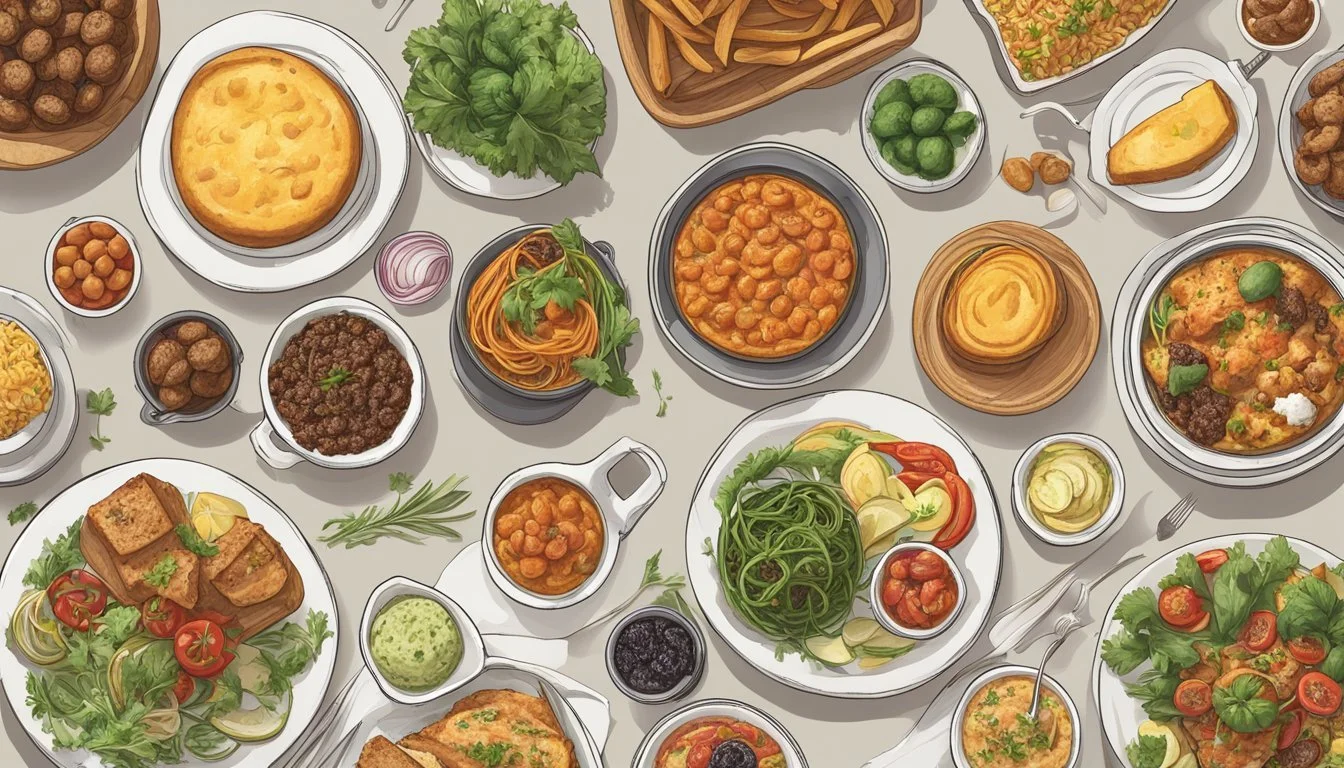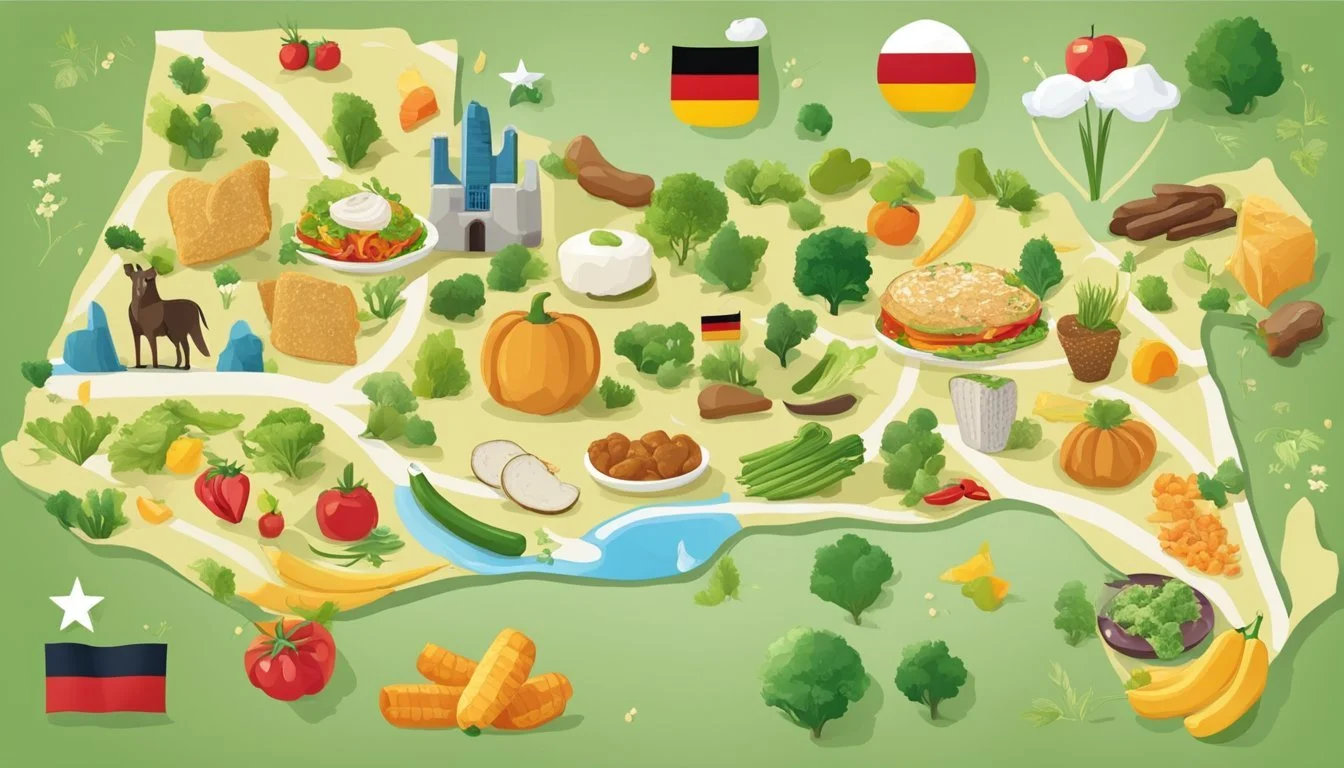The Influence of German Cuisine on Texas Vegetarian and Vegan Cuisine
A Culinary Fusion Explored
The culinary landscape of Texas has long been a melting pot of diverse influences, with German settlers making a significant impact since their arrival in the 1800s. German immigrants integrated their rich food traditions with local Texan ingredients, which has resulted in unique culinary offerings. Notably, this fusion has left an indelible mark on the increasingly popular vegetarian and vegan movements within the state. Despite Texas being known for its barbecues and meat-heavy diet, there has been a remarkable rise in the number of establishments and options catering to plant-based diets.
Traditional German cuisine (What Wine Pairs Perfectly With German Cuisine) is often associated with meat-centric dishes, yet it also includes an array of plant-based recipes that have subtly influenced vegetarian and vegan food culture in Texas. For example, the German emphasis on garden vegetables and whole grains creates a natural similarity to vegetarian principles. In conjunction with modern dietary shifts and health trends, Texas has seen an adaptation of traditional German dishes into vegetarian and vegan forms. Establishments may offer vegan sausages made from plant-based proteins, maintaining the hearty flavors without the use of animal products.
This adaptation exemplifies the fusion between German culinary practices and contemporary Texan dietary preferences. As the state becomes more welcoming to plant-based diets, the heritage of German cuisine continues to evolve, proving its resilience and adaptability in the face of changing food culture trends.
Historical Origins of German Influence in Texas Cuisine
The introduction of German culinary traditions to Texas by early European settlers laid the foundational influence of what would evolve into the state's rich gastronomic tapestry, harboring a profound impact on its vegetarian and vegan cuisine.
German Immigrant Contributions
German immigrants began settling in Texas in the early-to-mid 19th century, primarily in the rural Hill Country region, founding towns such as New Braunfels and Fredericksburg. They brought with them Old World recipes that had been passed down through generations. These settlers introduced a range of vegetarian staples like sauerkraut, root vegetables such as potatoes and carrots, and a variety of grains and legumes to the Texas culinary scene. Their appreciation for garden-fresh produce contributed significantly to the vegetarian aspect, while their traditional techniques of pickling and preservation expanded the food preparation methods available to Texans.
Early Texas-German Culinary Fusion
As the German settlers became part of the fabric of local society, they invariably mixed their European culinary heritage with that of their new home, leading to an early fusion of flavors. They adapted to the ingredients available in Texas, utilizing local produce such as tomatoes, corn, and beans in their traditional recipes. These adaptations led to the creation of unique vegetarian and vegan dishes that still hold a place at Texas tables today. Innovations included the use of native Texas pecans and black-eyed peas, which were incorporated into German recipes, offering new textures and flavors that have become staples in the American settlers' diets.
Influenced by this rich cultural heritage, modern Texan cuisine, including its vegetarian and vegan variations, continues to celebrate these early Texan-German culinary marriages.
Fundamentals of German Cuisine
German cuisine, known for its hearty flavors and wide variety of dishes, makes extensive use of meats, vegetables, and potatoes, often accompanied by a frothy beer.
Characteristics of Traditional German Foods
Traditional German foods are characterized by their hearty and filling nature, primarily focusing on meat as a staple. Pork is particularly prevalent, manifesting in various forms from smoked ham to tender schnitzels. An array of sausages, known as Wurst, also define German cuisine, each with unique seasonings and preparation methods. The consumption of beer, as a beverage staple, complements meals and is integral to German food culture. Sauerkraut, a fermented cabbage dish, serves as a tangy condiment, rich in flavor and tradition.
Meat: Predominantly pork, found in schnitzels, bratwurst, and ham.
Sausage: Diverse range, including bratwurst, knackwurst, and weisswurst.
Beer: Various styles that are often paired with meals.
Sauerkraut: Fermented cabbage, adding a sharp taste to dishes.
Vegetarian Staples in German Diet
Despite the dominance of meat in German cuisine, numerous vegetarian staples are integral to its offerings. Potatoes are a fundamental element, prepared as dumplings, salads, or mashed. Vegetables like cabbage, carrots, and beans frequently accompany meals either as side dishes or incorporated into main courses. Root vegetables are often roasted or stewed, adding depth of flavor and nutrition. Lastly, hearty breads, representing the grain element, are omnipresent and diverse, including ryes, pumpernickel, and pretzels.
Potatoes: Versatile, found in dishes like potato salad and dumplings.
Vegetables: Cabbage, carrots, beans, and more, in salads or sides.
Breads: Varied, including dark ryes and soft pretzels.
Texan Culinary Landscape
The culinary scene in Texas reflects a rich mosaic of cultures, from traditional Southern and Tex-Mex to innovative vegetarian and vegan adaptations. Its evolution and current movements toward plant-based dining underscore a dynamic shift in the Texan palate.
Evolution of Texas Cuisine
Texas cuisine has historically been a hearty fusion, reflecting its geographic and cultural diversity. Cities like Austin, Dallas, Houston, and San Antonio each boast their own signature dishes, yet they share a common thread of Southern, Mexican, and Texan culinary traditions. Early influences from German and Czech settlers introduced a variety of pastries and baked goods, leaving a notable mark on Texan food culture. Over time, this intermingling of tastes and recipes evolved; adaptations of classic dishes emerged, such as Tex-Mex, a flavorful blend of Texan and Mexican cuisines with items like chili con carne and fajitas becoming staples. However, amid this evolution, barbecue maintained its status as an iconic element of the state’s gastronomy, characterized by slow-smoked meats (What wine goes well with smoked meats?) and bold flavors.
Rise of Vegetarian and Vegan Movements in Texas
Vegetarianism and veganism have seen a significant rise in Texas, particularly in urban centers where culinary innovation is embraced. The plant-based movement has been gaining ground, with Texas not only being home to traditional barbecue but also a growing variety of vegetarian and vegan options that cater to an increasing demand. Vegan twists on Tex-Mex cuisine are particularly popular, such as meat-free 'chicken' fried in a batter made from plant-based ingredients like seitan (What wine goes well with seitan?) or soy protein. This shift is most prominent in cities like Austin, known for its health-conscious community. Restaurants and food trucks across the state are redefining Southern comfort food by creating plant-based versions of Texan classics. There has been a notable integration of vegetarian and vegan principles into the traditional culinary framework, providing both vegans and vegetarians with a taste of Texas without compromising their dietary choices.
Impact of German Cuisine on Modern Texan Vegetarian Options
German cuisine has notably influenced the vegetarian scene in Texas by introducing ingredients and flavors that have been adapted into plant-based versions. This transition can be seen in an array of dishes and restaurant menus, indicative of a blend between traditional German and modern Texan vegetarian food culture.
German-Texan Vegetarian Dishes
Sausages: A quintessential element of German cuisine in Texas is the sausage, traditionally meat-based but now reimagined in vegetarian forms. Restaurants and food trucks are incorporating soy and seitan as alternatives to craft sausages that retain the hearty texture and savory spices characteristic of their German counterparts.
Potato Dishes: German-inspired potato dishes, such as kartoffelsalat (potato salad), have been reinvented using vegan mayonnaise and fresh herbs, found in many cafés and eateries across Texas.
Pretzels and Breads: Many bakeries offer a variety of German breads and pretzels made without dairy products, catering to a vegan audience while staying true to traditional recipes.
German Influences on Texas Vegan Restaurants
Vegan Options: Texas vegan restaurants are expanding their menus by integrating German touches into their plant-based offerings. Examples include:
Schnitzel: Crafted from ingredients like textured vegetable protein or wheat gluten, coated with spiced breadcrumbs, and fried to emulate the crispiness of the traditional dish.
Cheese Alternatives: Nut-based cheeses draw from German cheese-making techniques, giving rise to vegan versions of dishes like Käsespätzle (cheese noodles).
Fresh Produce: Emphasizing fresh greens, fruit, and nuts, Texas vegan restaurants frequently adapt German salads and sides, adding zest with local spices and seasonings to cater to both German and Texan palates.
Culinary Innovations and Adaptations
Texas's culinary scene has embraced the challenge of infusing German cuisine into vegetarian and vegan offerings, highlighting the innovative spirit of chefs and the growing demand for plant-based options.
Fusion Dishes
German cuisine, with its rich variety of flavors and ingredients, has been skillfully adapted into Texas's vegetarian and vegan scene. Chefs have created fusion dishes that maintain the heartiness of German classics while catering to plant-based diets. For example, traditional pasta dishes are now available with vegan sauces and cheeses, offering a comforting nod to German influences.
Sauerkraut and Mushroom Tacos: A Tex-Mex staple turned vegan by replacing beef with hearty mushrooms and sauerkraut for a German twist.
Vegan Rouladen: Rolling plant-based fillings such as lentils and smoked tofu in thinly sliced vegan meat substitutes reflects the German art of Rouladen, reimagined for a vegan audience.
Plant-Based Alternatives to German Meat Dishes
The transformation of meat-centric German dishes to plant-based delights showcases the innovative use of ingredients like tofu, seitan, and legumes. Chefs have redefined the concept of vegan brisket by using seitan, known for its meat-like texture, and flavoring it with traditional BBQ rubs and spices.
Vegan Brisket: Smoked seitan brisket, rubbed with classic spices to replicate the smoky taste of Texas BBQ.
Vegan Burgers: A variety of beans and grains form the base of these burgers, often incorporating sunflower seeds for a nutty flavor reminiscent of German cuisine's love for seeds and nuts.
Through these culinary adaptations, German influences thrive within Texas's vegetarian and vegan food culture, ensuring that even those following a plant-based diet can enjoy the state's rich heritage.
Cultural Interaction and Food
Drawing from a rich tapestry of cultures, Texas has become a melting pot where German cuisine's influence is palpable, even within its vegetarian and vegan culinary scenes.
German-Texan Food as Cultural Exchange
Cultural Heritage: Texas embodies a unique blend of southern, Mexican, French, Spanish, Indian, and Louisiana culinary influences. In this vibrant melting pot, German settlers left a distinctive mark. Their food traditions, especially in the preparation of smoked and cured dishes, have been expertly integrated, adapting to local tastes and available ingredients. While known for their meat-centric dishes, like the "Texas hot gut" sausage, these methods of smoking and curing have also been applied to non-meat ingredients to cater to vegetarians and vegans.
Local Adaptation: The melding of German and Texan flavors exemplifies a cultural exchange that extends beyond meat. Vegetarian cuisine often uses the same spices and smoking techniques rooted in German culinary practice, reimagined for plant-based alternatives.
Contemporary Trends in Vegetarian and Vegan Culinary Scenes
Vegan Adaptations: In contemporary Texas, the burgeoning vegan scene creatively infuses German-inspired techniques into vegan dishes. A prime example is the vegan fried chicken, where traditional frying and seasoning methods are maintained, yet the core ingredient is replaced with plant-based proteins like seitan or soy.
Festivals and Fusion: The positive reception of such dishes is bolstered at events such as Wurstfest, where embracing German heritage includes both traditional and contemporary takes on the cuisine. With Texas's openness to veganism, these culinary experiences now celebrate cultural history while meeting modern dietary choices, showcasing how even a state renowned for its barbecue can innovate within its vegetarian and vegan offerings.
Geographic Culinary Variations within Texas
Texas is a tapestry of regional cuisines, each with its unique spin on vegetarian and vegan dishes that are inspired by German culinary methods.
Cuisine Differences in Texas Regions
Each region of Texas adds its distinct flavor to the state's cuisine.
Austin and San Antonio: These cities have embraced a health-conscious lifestyle. Vegetarian dishes (What wine goes well with vegetarian dishes?) often incorporate kale, grains, and locally-sourced vegetables like onions and peppers. German influences are seen in the vegan adaptations of traditional pastries and the use of apples in savory dishes.
Dallas and Houston: These metropolitan areas have a high demand for diverse vegetarian options. Influenced by German cuisine, chefs in these cities may use squash and grains to craft hearty, comforting dishes reminiscent of German fare, but always with a vegetarian twist.
West Texas: Known for its agriculture and game, West Texas sees a vegetarian interpretation of German cuisine that might infuse flavors from the native prickly pear cactus or relying on locally available fresh greens.
Texas Hill Country: Here, fresh, fruit and vegetables are staples in the vegetarian diet. German-inspired dishes are abundant, with a focus on local ingredients like onions and apples, often found in farmers' markets and roadside stands.
Gulf Coast: The coast's rich maritime agriculture influences the vegetarian cuisine with local staples like rice. Here, German cooking methods may be used to enhance the natural flavors of fresh produce from both land and sea.
Local Ingredients and German-Style Cooking in Texas
Local Produce: Across Texas, the local produce plays a central role in vegetarian and vegan cuisine. Below is a breakdown of typical local ingredients:
Grains: rice, wheat
Fruits: apples, prickly pears
Vegetables: squash, kale, onions, peppers
Cooking Methods:
Grilling and Roasting: Emphasized in German cuisine, these methods are adopted to prepare vegetables like squash and peppers in a way that enhances their natural flavors.
Baking: German-inspired baking sees ingredients like apples and grains turn into vegan-friendly pastries and breads.
The integration of German cooking techniques with Texas's agriculture yields an exciting variety of vegetarian and vegan dishes that appeal to a diversity of palates.
Sustainability and Ethical Considerations
The intersection of German culinary traditions with Texas's vegetarian and vegan cuisine underscores an impactful convergence of taste and conscientious eating. This alliance serves not only to broaden the spectrum of flavors but also to promote sustainable and ethical consumption patterns.
The Role of Vegetarianism in Sustainable Eating
Sustainability in eating practices is deeply tied to a vegetarian diet, as it typically requires lower resource input compared to diets that include animal products. The agricultural sector, crucial in food production, is a major consumer of water and land resources. Vegetarianism, with its preference for plant-based foods, minimizes the environmental footprint by reducing the demand for these intensive agricultural processes. The shift towards vegetarianism is seen as a beneficial move:
Energy Efficiency: Producing plant-based foods often requires less energy compared to raising livestock.
Water Conservation: Vegetarian diets can lead to lower water usage as growing vegetables and grains generally consumes less water than animal husbandry.
Land Usage: It utilizes land more efficiently by growing food directly consumed by humans rather than feeding livestock.
From an ethical standpoint, vegetarianism in Texas, influenced by German roots, has evolved to embrace both traditional flavors and modern sustainable practices.
German-Texas Vegetarianism and Ethical Eating
German influence on Texas's culinary landscape extends to ethical eating, where vegetarian and vegan diets play a pivotal role. Ethical considerations often involve concerns over animal welfare, seeking to minimize harm to animals through dietary choices. The prevalence of a plant-based diet serves as a bridge between ethical values and cultural heritage, allowing consumers to maintain traditional German-Texan tastes while adhering to moral food consumption principles:
Avoidance of Animal Suffering: Choosing plant-based alternatives to traditional sausages and other meat-based products reduces reliance on animal agriculture.
Health Benefits: Ethical choices often coincide with health benefits, as many vegetarian dishes are lower in saturated fats and cholesterol.
Through the fusion of German-inspired vegetarian cuisine, Texas presents a unique example of how traditional food can adapt to embody sustainable and ethical principles.
Conclusion
The intermingling of German culinary traditions with Texas plant-based fare has birthed an innovative and distinct cuisine. German settlers have imprinted their sausage-making heritage into the Texan food scene, and today, vegetarian and vegan alternatives reflect this influence. Plant-based sausages, drawing on German techniques, have risen in prominence amidst Texas's diverse food culture.
Modern Texan chefs and home cooks often employ ingredients like seitan, soy, and chickpeas to mimic the texture and flavor of traditional meat sausages. These ingredients are spiced and cooked to create a vegetarian or vegan option that honors the German legacy. Events such as the Wurstfest in New Braunfels showcase the fusion of these culinary practices, indicating a broadening acceptance and celebration of this cuisine blend.
The growth of the vegan movement in Texas further solidifies the state's openness to plant-based adaptations of meat-centric dishes. Restaurants and food festivals are increasingly featuring options that ensure vegetarians and vegans can enjoy the flavors of German-influenced Texan cuisine without compromise.
Indeed, the legacy of German cuisine in Texas extends its reach into the plant-based diet, proving that traditional flavors can be respected and preserved even as dining habits evolve. This influence stands as a testament to the adaptability of culinary culture, managing to thrive in a landscape traditionally dominated by meat.









